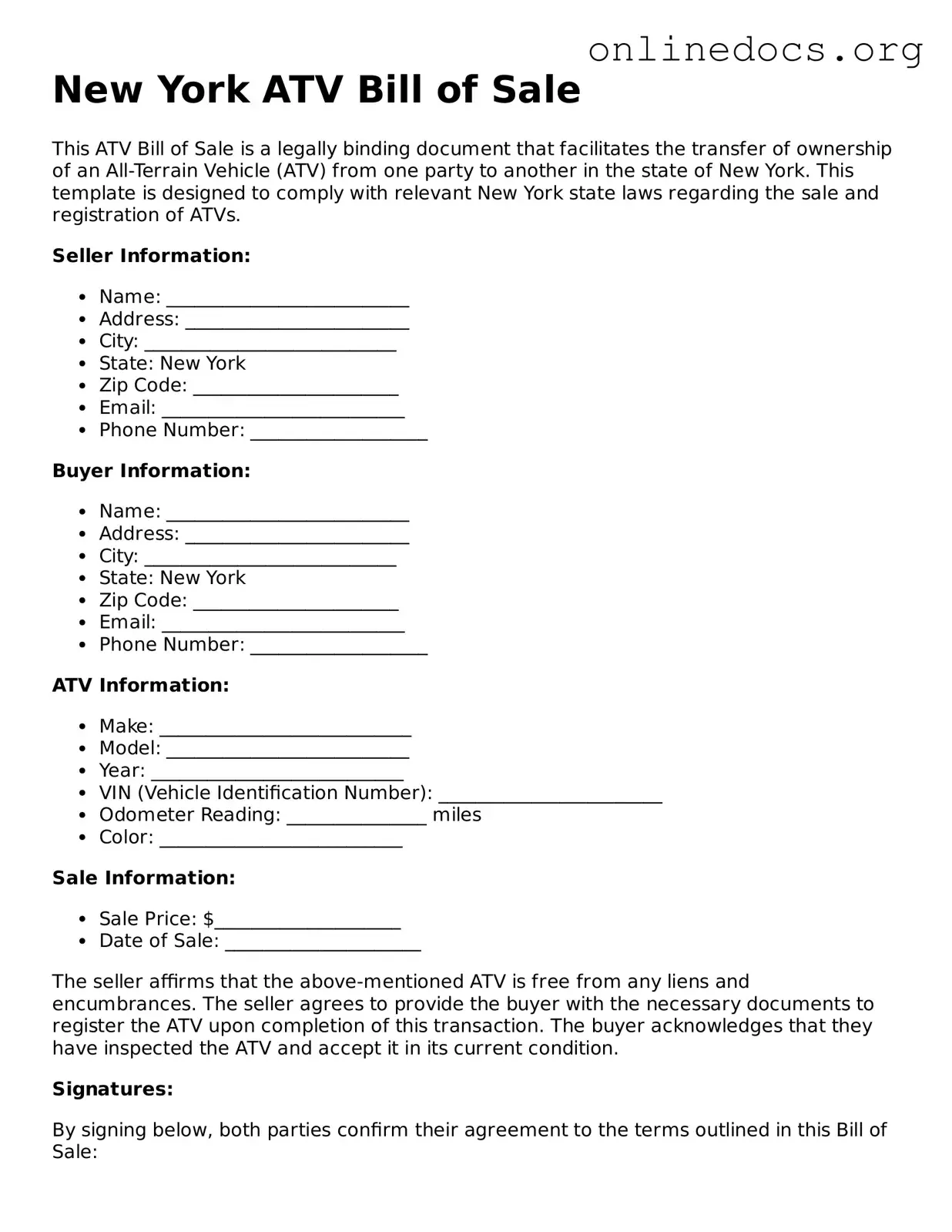The New York Boat Bill of Sale is similar to the ATV Bill of Sale in that both documents serve as proof of transfer of ownership for vehicles. When a boat is sold, the seller must provide a bill of sale to the buyer, detailing the vessel's specifications and the transaction terms. This document is essential for registering the boat in the new owner’s name, just as the ATV Bill of Sale is needed for ATVs. Both documents include information such as the purchase price, date of sale, and the parties involved in the transaction.
The New York Motorcycle Bill of Sale also mirrors the ATV Bill of Sale. Both documents facilitate the transfer of ownership for motorized vehicles. When purchasing a motorcycle, a bill of sale is required to document the sale and ensure the new owner can register the motorcycle with the Department of Motor Vehicles. Each document typically includes similar details, including vehicle identification numbers, seller and buyer information, and the sale price.
The New York Car Bill of Sale is another document that shares similarities with the ATV Bill of Sale. Both serve as legal proof of ownership transfer for motor vehicles. A car bill of sale includes vital information such as the make, model, year, and VIN of the vehicle. Like the ATV Bill of Sale, it protects both the buyer and seller by documenting the transaction details and providing a record for future reference.
The New York Snowmobile Bill of Sale is akin to the ATV Bill of Sale in that it documents the sale of a recreational vehicle. This document is crucial for the buyer to register the snowmobile legally. It includes similar elements, such as the description of the vehicle, the sale price, and the identities of both the buyer and seller, ensuring a smooth transfer of ownership.
The New York Trailer Bill of Sale is comparable to the ATV Bill of Sale as it serves to confirm the sale of a trailer. Both documents require details about the trailer, including its specifications and identification numbers. The trailer bill of sale is necessary for registration and helps protect the rights of both parties involved in the transaction.
The New York Farm Equipment Bill of Sale is another document that resembles the ATV Bill of Sale. It facilitates the transfer of ownership for agricultural machinery. This bill of sale includes information about the equipment, such as its make, model, and serial number. Just like the ATV Bill of Sale, it provides a clear record of the sale, which is essential for both the buyer and seller.
The New York Personal Watercraft Bill of Sale shares similarities with the ATV Bill of Sale as both documents are used for the transfer of ownership of recreational vehicles. When a personal watercraft is sold, a bill of sale is required to document the transaction. It contains information similar to that found in the ATV Bill of Sale, including the purchase price, the date of sale, and the details of both parties involved.
The New York Aircraft Bill of Sale is another relevant document. While it pertains to a different type of vehicle, it serves the same purpose of establishing ownership transfer. The aircraft bill of sale includes comprehensive details about the aircraft, such as its registration number and specifications. Like the ATV Bill of Sale, it provides a legal record of the transaction that protects both the buyer and seller.
When engaging in any sale of personal property, it's crucial to establish a clear record, and the All Templates PDF provides valuable resources for creating the necessary documentation. Such records not only help with the transfer of ownership but also protect the interests of both parties involved in the transaction.
The New York Lease Agreement can also be compared to the ATV Bill of Sale in terms of documenting a transaction. Although a lease agreement outlines the terms for renting rather than selling, it still requires detailed information about the parties involved and the item being leased. Both documents serve as legal records that clarify the terms of the transaction, ensuring that both parties understand their rights and obligations.
Finally, the New York Gift Bill of Sale is similar to the ATV Bill of Sale in that it documents the transfer of ownership without a monetary exchange. This document is used when a vehicle, such as an ATV, is given as a gift. It includes the same essential details as the ATV Bill of Sale, ensuring that the transfer is legally recognized and that both parties have a record of the transaction.
